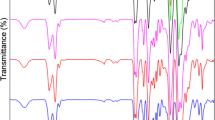Abstract
Eight series of polymers containing 2, 4 toluene di-isocyanate (2, 4 TDI) or 2, 6 TDI, butanediol and 1000 or 2000 molecular weight polyether or polyester soft segment were prepared, and their thermal transitions and structures studied by differential scanning calorimeter, thermo-mechanical analysis, infra-red spectroscopy and X-ray methods in order to obtain the effect of compositional variables on transition behaviour, the extent of phase segregation, and polymer properties. Results indicate that polyester soft segment contributes to greater phase mixing than the polyether, even competing with crystallization of 2, 6 TDI hard segment. This implies that hydrogen bonding of urethane NH to polyester is stronger than to polyether. In weakly phase-segregated samples, hydrogen bonding in the mixed phase raises the T g beyond the value predicted from the copolymer equation and i.r. estimates of the degree of phase mixing. The additional increase in T g can be accounted for by treating hydrogen bonding as cross-links. The results also indicate the effectiveness of increased polyether soft segment molecular weight in promoting phase segregation while less pronounced molecular weight effects occur with polyester soft segment. Thermal behaviour of hydrogen bonding suggests that the cause of hydrogen bond dissociation bears little relation to the state of structural organization.
Similar content being viewed by others
References
N. S. Schneider, C. S. Paik Sung, R. W. Matton and J. L. Illinger, Macromol. 8 (1975) 62.
R. Bonart and E. H. Muller, J. Macromol. Sci. -Phys. B10 (1974) 177.
Idem, ibid. B10 (1974) 345.
W. J. Macknight and M. Yang, J. Polymer Sci. Part C 42 (1973) 817.
C. S. Paik Sung and N. S. Schneider, Macromol. 8 (1976) 68.
A. T. DiBenedetto, unpublished results (see L. E. Nielsen, J. Macromol. Sci., Rev. Macromol Chem. 3 (1969) 69).
E. A. Di Marzio, J. Res. Nat. Bur. Stand. 68 (1964) 611.
C. S. Paik Sung and N. S. Schneider, Macromol. 10 (1977) 452.
R. W. Seymour and S. L. Cooper, ibid. 6 (1973) 48.
N. S. Schneider and C. S. Paik Sung, Polymer Eng. Sci. 17 (1977) 73.
Author information
Authors and Affiliations
Rights and permissions
About this article
Cite this article
Paik Sung, C.S., Schneider, N.S. Structure-property relationships of polyurethanes based on toluene di-isocyanate. J Mater Sci 13, 1689–1699 (1978). https://doi.org/10.1007/BF00548732
Received:
Accepted:
Issue Date:
DOI: https://doi.org/10.1007/BF00548732



